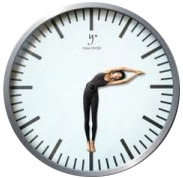 What is the Best Time of Day to Exercise?
What is the Best Time of Day to Exercise?
We all want to maximize the benefits of our fitness efforts. When it comes to the daily timing of our workouts, you may find that research on hormone levels, lung function, body rhythms, and temperature says to exercise around 6 pm.
However, various surveys you will find on exercise habits say something different. Mostly, the consensus is to exercise in the morning before other commitments begin to distract us.
So - let's explore the positives and negatives of the different times of day we could choose to exercise.
Mornings
Did you know: the majority of people who exercise consistently do so early in the day...
The Positives:
• It is easier to "make time" for exercise by getting up earlier.
• Your body eventually adjusts to your regular exercise time, so if you are training for a morning sports event, it makes sense to train in the morning.
• It is easier to form the exercise habit through morning exercise.
• If you exercise outside, air pollution is, in fact, lowest in the morning.
• Cooler temperatures (in summer especially).
• There are fewer distractions and schedule conflicts.
• Exercising early raises your heart rate and metabolism to eventually burn more calories earlier in the day.
• Provides a feeling of physical energy for hours into the day.
• Improves your mental awareness for hours.
• Gives a great sense of accomplishment. You've already completed a workout before breakfast, while the rest of the world snoozes.
The Negatives:
• Body temperature is at its lowest very early in the morning - probably a couple hours before you generally wake up. This means morning is a time of naturally lower blood flow and energy.
• Cold, stiff muscles may be more prone to injury. You will need to warm up appropriately before doing a higher intensity workout, and follow with gentle stretching.
• Because body temperature and hormones are higher in late afternoon, you may get the same (or even better) calorie-burning effects later in the day.
Midday or Lunch Time
The Positives:
• You can make a healthy habit to walk and exercise at lunch and break time.
• You can have access to an exercise partner at work or in your neighborhood.
• Can help regulate the amount of food you feel like eating for lunch, and help you avoid break-time snacking.
• Your body temperature and hormone levels are higher than early in the morning.
• Improves blood flow to the brain so you are more mentally acute in the afternoon.
• It is a well-timed stress relief from work or home stresses.
The Negatives:
• Did you know - lung function is worst at noon? For an easy workout, you may not recognize the difference. However, when performing a vigorous workout, you may actually feel the 15% difference.
• While any amount is better than none, time constraints may not allow you to get in a full workout.
• Inevitable daily commitments and distractions make detour you from exercising at the appointed times.
Afternoon
Research shows that afternoon (3 pm - 7 pm) is the best time to exercise for both endurance and muscle-building.
The Positives:
• For the majority of people, body temperature and hormone levels peak at 6 p.m. Exercising 3 hours before or after the peak will give your your best workout considering both endurance and building muscle.
• Research shows lung function is best at 4 pm - 5 pm.
• Muscles are nice and warm and more flexible than other times of day.
• Your perceived exertion is lowest than any other time. Therefore, you may be able to work out harder or faster in the afternoon.
• Effective stress relief after a day at work, or home stress.
• This can help regulate the amount of food you feel like eating for dinner. YEAH!
The Negatives:
• Distractions and other commitments could keep you from exercising at these times.
Evenings
The Positives:
• Muscles are still warm and flexible.
• Perceived exertion is low. You may be able to work out harder than you would earlier in the day.
• This time can help regulate the amount of food you feel like eating for a later dinner.
• Stress relief after a long day.
The Negatives:
• Distractions and home life may keep you from exercising at this time.
• At darker times of the year, you will need to wear reflective gear outside.
• You will need to allow one to three hours to wind down after exercising to be able to fall asleep. If you discover sleeping problems, schedule your workout earlier.
The Bottom Line: Exercising can only do you good if you actually do it! You can take the above information into deep consideration, and use it to your advantage. However, the best time to exercise is the time that will fit best into your schedule so you can do it consistently. Experts agree -- it is not the time of day that matters as much as finding the time you can set aside consistently for your workouts.